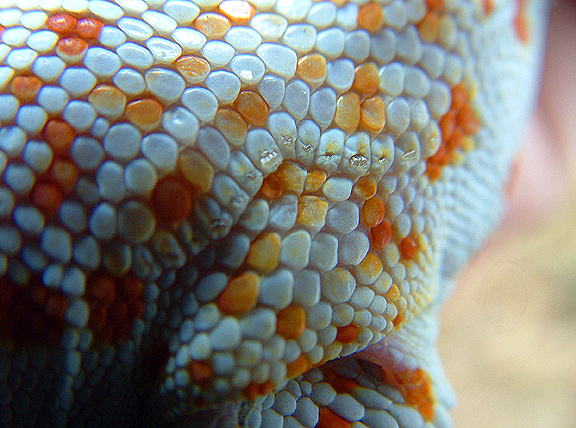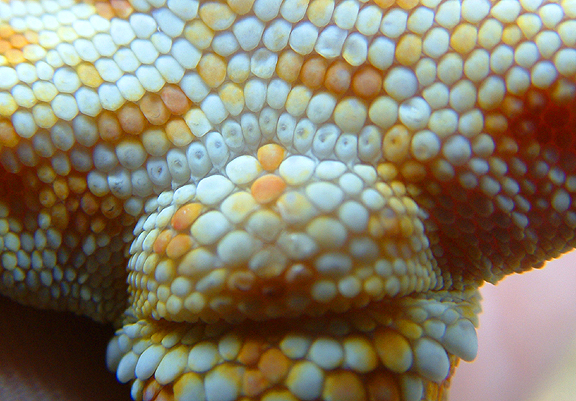Most lizards can detect airborne sounds, but only the nocturnal geckos from the subfamily Gekkoninae regularly use acoustic signals for communication. Geckos are unique in the lizard world in that they have vocal cords and as such can produce more complex sounds than hisses and gasps.
(Marcellini, 1977)
Males vocalise a territory and these are termed multi-chirp calls. These calls can be directed at specific males or females but are also given spontaneously as well. Sub-ordinate males move away from recordings of multi-chirp calls yet no response was elicited from females (the reproductive state of the females in question was not ascertained so the experiment does not necessarily show that the calls are not attractive to females. It is assumed that in fact they are.)
(Pough, 2001)
Vocalisations given during aggressive interactions are called churr calls. These consist of longer notes than those discussed in multichirp calls. This call is seen in altercations between conspecific males (one of which no doubt either ignored a multi-chirp call or was unnaturally enclosed in captivity with a male of assumed equal prowess in the vivarium – the latter being the most likely.) and humans or other perceived predators.
(Marcellini, 1977)
Tokay Geckos particularly have a very complex vocal repertoire. This species is unique in having a multipart advertisement call that begins with a rattling sound that is followed by a series of two-syllable chirps. Nothing is known about the significance of these call components, but it is possible that Tokays resemble some frogs in using part of the call to fend off males yet with another part to attract females.
(Brillet & Paillette, 1991)
*A difference noticed by the author between the sexes of the Tokays is the depth of the croak. What is discussed in text read in numerous places if the frequencies utilised by Tokay Geckos but no mention is made of the use of lower frequencies by males and conversely higher frequencies by females. The adult males that are in the collection have a much more powerful gruff deep voice where the females are more likely to squeak by comparison. I conclude that depth of voice may play a role in sex determination of Tokay Geckos. Although it must be noted that this has not been scientifically proven and is only the authors opinion.
A published & brief discussion of pre-anal pores and those of Tokay Geckos:
Pre-cloacal glands, the femoral pores or to be more precise inguinal pores were first described by Linnaeus (1758) (Funny that the Tokay was found and described the same year! – Could the two be connected). They are epidermal structures present in many lizards.
Pre-cloacal glands and femoral pores when considered in comparative anatomy are said to be homologous (features that may have the same evolutionary origin but not necessarily the same function. - D.C.Wareham, 2005.)
(Gabe and Saint Girons, 1965)
The glands produce copious amounts of holocrine secretion as a solid core and appear mostly in males. The pores are invariably larger in males. The amount of secretion produced in different seasons has never been measured quantatively, but it is generally accepted that femoral glands secrete more actively in the breeding season.
(Gans & Crews,1992)
* Much text found about Tokay Geckos says how easy it is to sex this species due to the male having pre-cloacal pores, what the various texts fail to mention is that the females also have them. When considering Leopard Geckos (Eublepharis Macularius) males have hollow pores which are visible and males are determined by their presence regardless of whether holocrine plugs are present or not. Females look to almost have vestigial marks on the scales but seem to lack the capability to exude holocrine plugs from them. This is not I have discovered the case in Tokay Geckos. Females too have hollow pre-cloacal pores although no plugs have been found to be present in any of the females. In the males the pores are only slightly bigger yet they do have holocrine plugs present. I conclude that by using these pores alone it may not be totally reliable to sex them unless you are fortunate to have number present for comparison. The use of these pores in conjunction with other variables used to distinguish sex may still be useful. Other variable will be discussed later.
In time I will add more pictures comparing these pores. The granite pair which I keep together produced an egg, yet both have pre-anal pores and both have endolymphatic calcium sacs. So other factors such as size, build, depth of voice must also be taken into account. |
|







